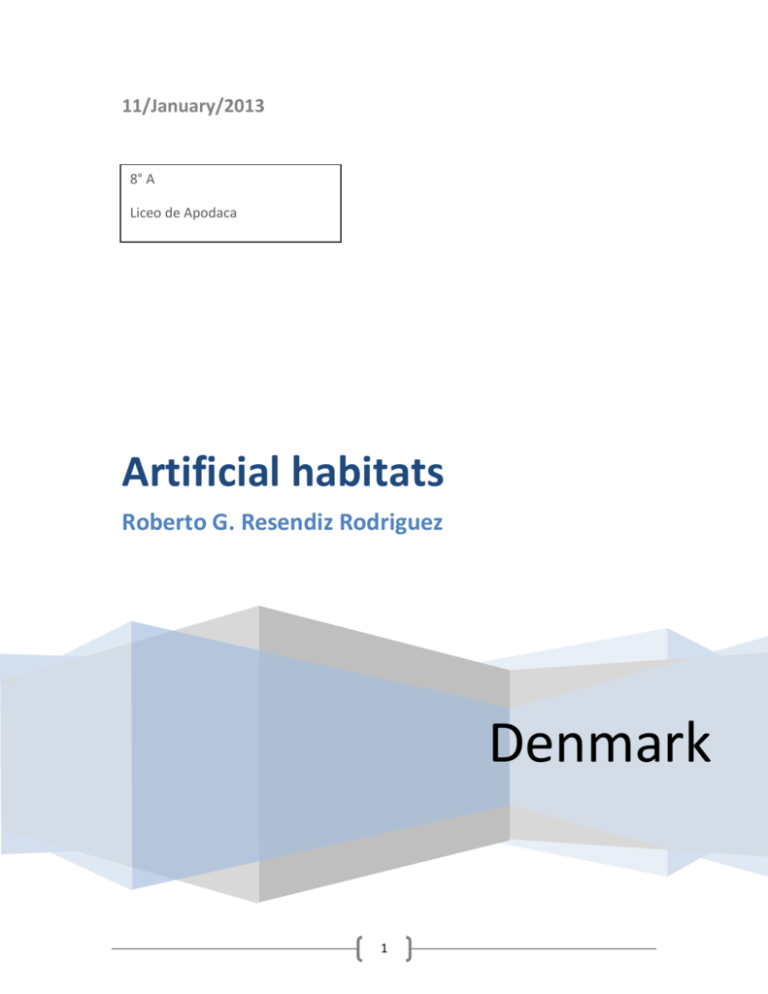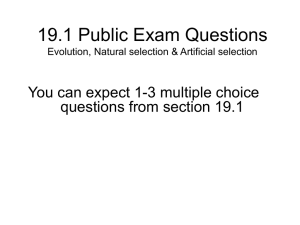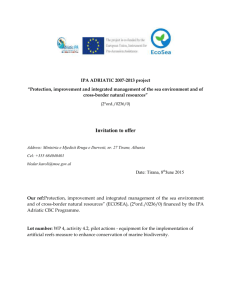Benefits of artificial habitats
advertisement

11/January/2013 8° A Liceo de Apodaca Artificial habitats Roberto G. Resendiz Rodriguez Denmark 1 Index Front……………………………………………………………………………………………………………………………1 Index…………………………………………………………………………………………………………………………..2 What is an artificial habitat?............................................................................................3 Aquatic artificial habitats…………………………………………………………………………………………….4 Terrestial artificial habitats………………………………………………………………………………………….5 Use of artificial habitats………………………………………………………………………………………………6 Benefits of artificial habitats……………………………………………………………………………………….7 Pros and cons of artificial habitats……………………………………………………………………………..8 Conclusion…………………………………………………………………………………………………………………9 What is an artificial habitat? An artificial habitat is a habitat that has been affected by humans in some way, usually that has been changed for a purpose. For example: a field that is now growing crops an area of woodland that has been cleared for home. They can be divided in two parts aquatic and terrestrial Aquatic: Terrestrial: Aquatic artificial habitats Artificial habitats have been used for centuries to successfully modify environments for the benefit of Man. In the aquatic environment, the use of artificial habitat technologies is of growing interest worldwide. Opportunities exist in both developed and developing nations to apply these technologies in many areas, including classical scientific investigations of ecosystem structure and function, engineering advances in underwater technology, and fisheries and environmental management. The applications of artificial habitat technologies are taking on ever greater economic, social, and environmental importance globally, not only in developed countries such as Japan where highly sophisticated technologies are used, but also in developing nations, where lower cost practices are in use. There is growing pressure to increase production, while at the same time preserve or enhance the environments and ecosystems surrounding fisheries. This book provides a comprehensive review of the facts, issues, and global trends emerging regarding the use of artificial habitats in aquatic ecosystems. It presents the most recent scientific advances in ecology and engineering technologies related to the building of artificial habitats, and it also presents many of the fisheries management and socioeconomic and environmental issues. Artificial Habitats for Marine and Freshwater Fisheries will be of interest to a broad audience including natural resource scientists, planners, and managers, particularly those interested in aquatic and fisheries science and management, organizations and individuals interested in commercial and recreational fishing, ecologists, environmental economists, engineers, lawyers, and social scientists, and geographers. Terrestrial artificial habitats Artificial refuges can be used to determine the presence of terrestrial fauna and to replace or enhance lost or degraded natural habitat. Concrete pavers, roof tiles, sheets of galvanised iron and old fence posts were used at three sites in southern and western Victoria to determine the presence of small terrestrial vertebrates and to provide artificial habitat. Twenty species were recorded comprising two mammals, 12 reptiles and six amphibians. Fat-tailed Dunnart Sminthopsis crassicaudata was recorded on eight occasions using roof tiles in a lightly grazed, grassland site on the Victorian Volcanic Plain. Growling Grass Frog Litoria raniformis was found under old fence posts beside a restored wetland. Little Whip Snake Parasuta flagellum was recorded under artificial refuges from areas with thick grass or tussock cover. Spotted Marsh Frog Limnodynastes tasmaniensis was found in large numbers under all forms of artificial habitat. Concrete pavers and old fence posts returned the highest diversity of species and the greatest number of individuals. The usefulness of artificial terrestrial habitat as a survey method is compared with other survey methods. The value of artificial habitat as a management tool and associated problems are discussed. Use of artificial habitats In 1999, the Southern Division American Fisheries Society Reservoir Committee conducted a survey to identify state agency goals, uses, and perceived effectiveness of artificial habitat structures in lakes and reservoirs. Of those states surveyed, 82% conducted some type of enhancement. In most states, 20% percent of water bodies received enhancement although respondents usually believed a larger portion of lakes and reservoirs (>40%) needed enhancement. Although several objectives were identified, most structures were placed to attract fish to increase angler catch rates. When asked to rate the effectiveness of structures on a scale of one (very satisfied) to five (very dissatisfied) with regards to agency objectives, most structures received a mediocre rating with mean values lying between two and three. Although abut 60% of states reported evaluation of structures, evaluations usually were testing for differences in fish abundance or angler catch rates between habitat structures and control areas. Few studies documented effects of structures on fish recruitment or population size. More studies are needed to assess effects of habitat structures on recruitment and abundance of sport fish in lakes and reservoirs. Readers are referred to an online habitat enhancement manual for more information on structures reported in this survey. Benefits of artificial habitats (example) Evidence for red snapper, Lutjanus campechanus, production from artificial habitats has been difficult to obtain. The benefits of such habitats for red snapper were evaluated by examining red snapper diets, predator exclusions, habitat complexity, and epibenthic communities in association with artificial habitats over a 10 year period. Also examined were movement patterns from ultrasonic telemetry, and population parameters estimated from fishery independent methods. These studies suggested that red snapper: 1) had a high affinity for artificial habitats, 2) showed consistent feeding on reef prey types, 3) were significantly more abundant on habitats with available prey, 4) showed a significant correlation between abundance and habitat complexity, 5) showed long term residency with some tracked over two years, and 6) abundance significantly increased when predators were excluded. In addition, population status of red snapper off coastal Alabama based on a fishery independent survey of 94 artificial habitats, using fish traps, diver surveys, and otolith aging suggested a better condition compared to previous population assessments. Collectively these results suggest that artificial habitats in the northern Gulf of Mexico contribute significantly to the production of red snapper. Pros and cons of artificial habitats (marine) Pros Artificial reefs take control of a natural feature of the ocean landscape for human and aquatic aims. Natural reefs have as much biodiversity as rain forests, so one way to promote the biodiversity of the ocean is to build reefs where life can prosper. The erosion of natural reefs, through man-made or natural causes, creates a need for aquatic habitats that artificial reefs can fill. A healthy ocean can rebuild fish populations and help create a sustainable fishing industry. Plus, artificial reefs, like natural ones, are beautiful places to visit, teeming with exotic life; they can help tourist trades and give people an opportunity to see an underwater world. Cons Building reefs is controversial, however, because many conservation groups, such as the Ocean Conservancy, oppose their construction. Their concerns are legion: the material used in the artificial reef will contaminate the environment by rusting or releasing toxins; countries and businesses can use the excuse that they are building an artificial reef when they leave their junk in the ocean; creating an artificial reef may harm an environment filled with life that's already there; artificial reefs tend to concentrate large populations of fish in one area, which may lead to overfishing. Conclusion The artificial habitats are habitats made by human to approach the nature resources. Sometimes the animals or plants are beneficiated like the red snapper. Sometimes some animals are beneficiated in a artificial habitat because they can have food without search it, they can live without predators and they have a better space to reproduce themselves. But the really intention of artificial habitats is to beneficiate the humans. The humans are beneficiated by the artificial habitats by getting food or resources of animals, hunt without extinct an animal race, protect a house a building or place or to decorate their homes with little artificial habitats. The artificial habitats make a symbiosis with animals, plants and humans where both are beneficiated in every ways but the point is that everybody are beneficiated with artificial habitats.






